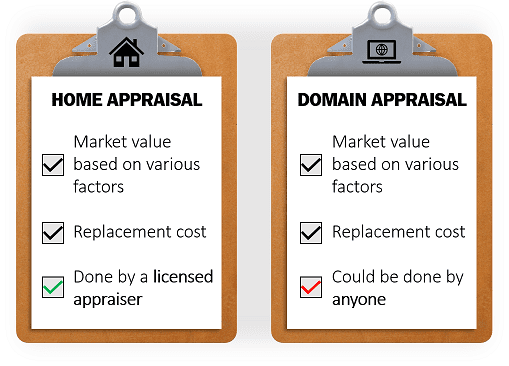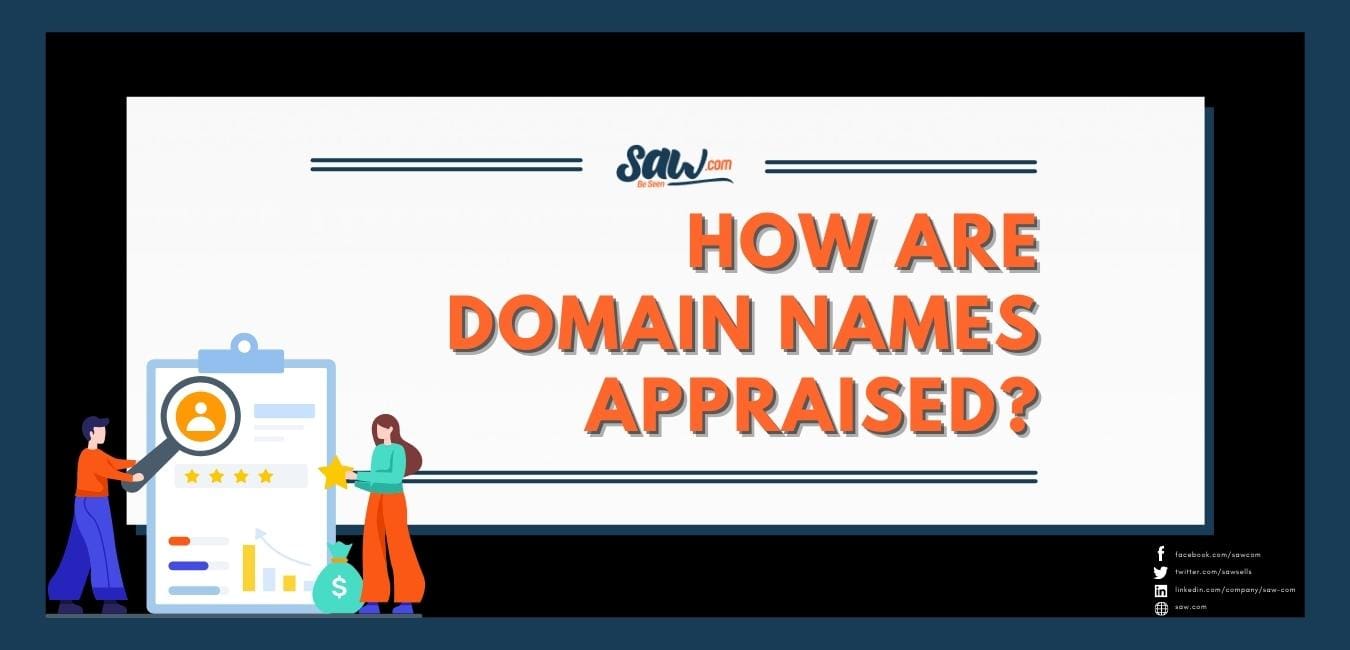Whether you own a domain or are looking to buy a domain, you will need to perform a domain appraisal. If you own an asset like a domain name, it is crucial to have an understanding of how domain pricing works and how to get your domain appraised.
Understanding domain pricing as a domain owner and buyer can give you power during sales. Why? Having knowledge about domain pricing will ensure you do not settle and do not break the bank when buying or selling a domain.
So, how are domain names appraised? What factors affect a domain appraisal? Let’s discuss.
Domain Appraisals
Domain appraisals allow you to gather information on a domain name, like the estimated value and how it compares to other domains. Think of it like a home appraisal. When refinancing, buying or selling a home – you need your home appraised. A home appraisal looks at the location, square footage, age, collateral, condition, and comparable sales in the area of the house. Furthermore, a home appraiser calculates two values for the home: the fair market value of the property and replacement cost of the property.
How is this related to domain names?
There are a few different values that are calculated when appraising a domain, similar to appraising a home. Also, similar to home appraisals, there are certain factors and metrics used to determine a fair market value for domains. One difference between home and domain appraisals is that while home appraisers are always licensed professionals, anyone can appraise a domain.
Factors of a Domain Appraisal
When you are getting a domain name appraised, there are a few factors and metrics that will affect the price of the domain name. It is important to keep these in mind when choosing a domain name.
Top-Level Domain (TLD) vs other domains
There are a few different extensions that affect the value of a domain. There are top level domains ( .com, .net, .org, .biz, .edu and .gov). Country code top-level domains like (Germany, which is the second most-registered TLD next to .com), .co.uk (United Kingdom) and .ca (Canada). And generic top-level domain: Some examples are .agency, .ai, .email, .rentals.
Usually, the more common an extension, the more valuable it will be. In almost every case, a .com is going to be more valuable than a .biz or .agency. However, this depends on the target audience for the domain. are certain circumstances when a country code extension or another generic extension might be preferable to a .com or other top-level domain.
Brandability
If the domain you are selling or looking to purchase is brandable – the price will be higher. These domains are typically non-keyword, general or made up words. Think Google, Pinterest, Uber, etc.
Length
Usually, the shorter the domain, the more valuable.
Desired, premium domain names are short, easy to spell and easy to remember. Additionally, short domains help build company credibility. Would you trust ArtificalIntelligence123.com or AI.com?
Industry
What industry is the domain connected with?
Depending on the industry, a domain could change in value. For example, NFT’s and cryptocurrency are growing in popularity, so a domain related to the industry is more desirable.
Market Trends
When appraising, you can look at trends for many different situations. One easy way to find trends is to visit trends.google.com. It’s a search tool that shows you the number of searches for any term over time. From this data, you can discern the interest or demand for a domain name you might be looking to purchase.
Spelling
Is the domain hard to spell? Easy to spell?
Generally, the easier to spell the domain is, the more desirable and more expensive. This is because it is easier for customers to remember and find, and tell others about your company
Domain Age
The age of the domain is another metric that has a huge effect on the price of the domain. If the domain was registered 30 years ago, it is most likely a highly desired domain compared to domains registered in the last year.
Comparable Sales
This metric is similar to appraising a home. You look for domains that are similar, more desirable or less desirable than your domain and find some middle ground. This allows you to get an idea of what the domain valuation market is like.
How are Domains Appraised?
I got my start in sales almost twenty years ago selling home loans. The three items that are always needed for any home loan are the three Cs: Cash, Credit, and Collateral.The first two Cs of the three Cs are self-explanatory, but the third C gets quite complicated. Collateral value, or the fair market value of an asset, requires an appraisal.
A home appraisal takes into account:Location, Square Footage, Age, Condition, and comparable sales within a reasonable distance from the property. Sounds simple, but it’s not quite as simple as it sounds.When you purchase a home, it is appraised to determine collateral for the loan.
Appraisers typically take a few superior properties and adjust down whether they are larger, in a better area, or in better condition. They also adjust the value up by comparing the home to inferior properties. Once the information regarding the home is tabulated and submitted, they calculate two different values:
#1 – The fair market value of the property.
#2 – The replacement cost of the property.
Typically, (not always) the price to rebuild the property in the case of a total loss is less than the market value of the property.
The replacement cost is submitted to the insurance company to determine how much your homeowner’s insurance policy will be.After the home is appraised, a third type of value is calculated for the home. It is called the assessed value, or tax assessment.
This assessment is usually far less than the fair market value of the property, and less than the replacement cost. It has to do with how much real-estate tax you will owe on the home. The more your home is worth, the more your taxes will be.
What does this have to do with domain appraisals? First, there are different kinds of appraised values for domains that are similar to the ones I have listed above (fair market, replacement cost). Also, similar to home appraisals, there are certain factors and metrics used to determine a fair market value for domains.Before we get started on domain appraisals, you should know a key distinction between real estate appraisals and domain appraisals.
With any real estate appraisal, the appraiser puts their credentials on the first or second page of the appraisal. This is because real estate is a heavily regulated industry that requires licensing. The domain industry is not as heavily regulated as real estate. So, while it can be safely assumed a home appraiser has a license, it could be anyone in the domain industry.

Interested in Speaking With One of Our Domain Brokers?
With these factors and metrics in mind, you can learn more about the industry and make informed decisions when appraising your domain. Whether you have a domain name in mind, or are looking for more information on a domain name – Saw.com has you covered!
If you are interested in speaking with an expert from our domain brokerage service about buying a domain, please contact us for a free consultation. Our domain brokers would love to speak with you!
A domain name is essentially your street address, but online. It is how new and returning customers will find you and shop with you. The easier it is to find you, the more likely customers are to return to your site.
Our team of domain brokers have over twenty years of experience in the industry. Our domain brokers are experts in domain acquisition, appraisal, branding, brand protection, portfolio management services and more.

